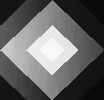"Diamond"




The image restoration problem deals with images corrupted by noise. The problem is to clear images from the noise.
The first column in the table below shows a synthetic "Diamond" image corrupted by Gaussian noise. The restored images are generated by an algorithm based on a graph-cut approach to MAP-MRF estimation. We show the results for the generalized Potts model of MRF (see references below) for three different values of the smoothness parameter "lambda". Note that all images below were slightly adjusted to show the texture.
| Noisy Image "Diamond" |
Restored Images (Generalized Potts Model) | ||
|---|---|---|---|
| lambda=0.3 | lambda=1.4 | lambda=50 | |
 |
 |
 |
 |
The next table shows slightly more challenging example of a noisy image. The "Shaded Diamond" image has several rectangular regions where intensity changes smoothly. Intensity discontinuities that occur at the borders of these rectangles are still sharp. Here we compare the results obtained by the graph cut algorithms in case of the generalized Potts model and in case of the linear clique potential model (see references below). The first model tends to create segments of constant intensity. The linear clique potential model gives more realistic results in this example.
| Noisy Image "Shaded Diamond" |
Restored Images | |
|---|---|---|
| Generalized Potts Model | Linear Clique Potential | |
 |
 |
 |